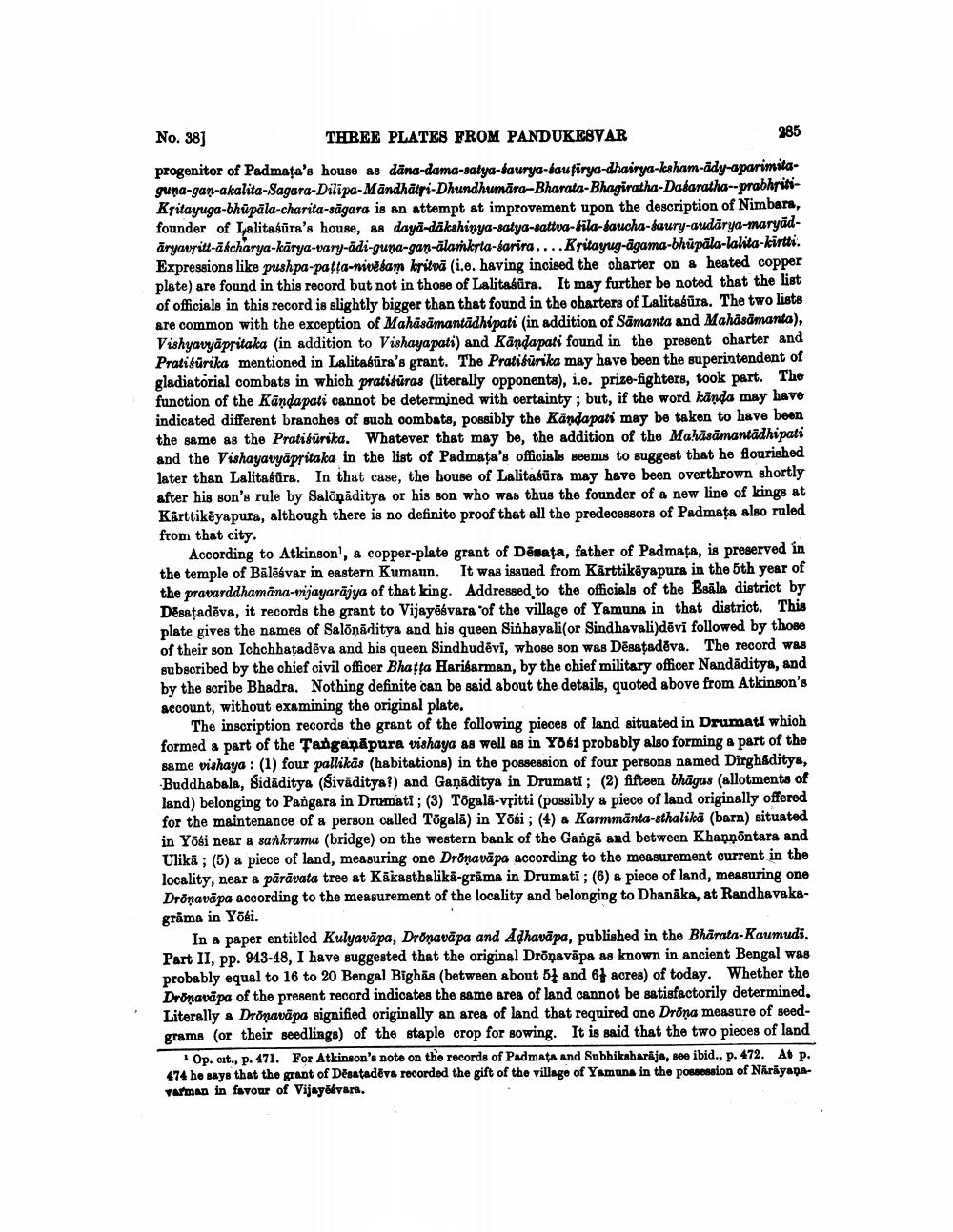________________
No. 38) THREE PLATES FROM PANDUKESVAR
285 progenitor of Padmata's house as dāna-dama-satya-saurya-baufirya-dhairya-ksham-ādy-aparimitaguna-gan-akalita-Sagara-Dilipa-Māndhātri-Dhundhumāra-Bharata-Bhagiratha-Dasaratha--prabhritiKritayuga-bhūpāla-charita-sägara is an attempt at improvement upon the description of Nimbara, founder of Lalitaśūra's house, as daya-däkshinya-satya-sattva-fila-saucha-laury-audārya-maryādāryavritt-abcharya-karya-vary-ādi-guna-gan-alankpla-sarira....Kitayug-agama-bhūpāla-lalita-kirtti. Expressions like pushpa-patta-nivētam kritvā (i.e. having incised the charter on a heated copper plate) are found in this record but not in those of Lalitaśūra. It may further be noted that the list of officials in this record is slightly bigger than that found in the charters of Lalitaśūra. The two lists are common with the exception of Mahäsämantādhipati (in addition of Samanta and Mahäsämanta), Vishyavyāpritaka (in addition to Vishayapati) and Kändapati found in the present charter and Pratisürika mentioned in Lalitabūra's grant. The Pratifurika may have been the superintendent of gladiatorial combats in which pratituras (literally opponents), i.e. prize-fighters, took part. The function of the Kāndapati cannot be determined with certainty ; but, if the word kanda may have indicated different branches of such combate, possibly the Kändapati may be taken to have been the same as the Pratiśürika. Whatever that may be, the addition of the Mahāsāmantādhipati and the Vishayavyāpritaka in the list of Padmata's officials seems to suggest that he flourished later than Lalitagūra. In that case, the house of Lalitabürs may have been overthrown shortly after his son's rule by Salonāditya or his son who was thus the founder of a new line of kings at Kärttikėyapura, although there is no definite proof that all the predecessors of Padmata also ruled from that city.
According to Atkinson, a copper-plate grant of Desata, father of Padmata, is preserved in the temple of Bālēsvar in eastern Kumaun. It was issued from Kärttiköyapura in the 5th year of the pravarddhamāna-vijayaräjya of that king. Addressed to the officials of the Esāla district by Dēsatadēva, it records the grant to Vijayisvara of the village of Yamuna in that district. This plate gives the names of Salonāditya and his queen Sinhayali(or Sindhavali)dēvi followed by those of their son Ichchhatadēva and his queen Sindhudēvi, whose son was Desatadēva. The record was subscribed by the chief civil officer Bhatta Haribarman, by the chief military officer Nandāditya, and by the scribe Bhadra. Nothing definite can be said about the details, quoted above from Atkinson's account, without examining the original plate.
The inscription records the grant of the following pieces of land situated in Drumati which formed a part of the Tangapāpura vishaya as well as in Yosi probably also forming a part of the same vishaya: (1) four pallikas (habitations) in the possession of four persons named Dirghāditya, -Buddhabala, Sidāditya (Sivāditya?) and Gaņāditya in Drumati; (2) fifteen bhāgas (allotments of land) belonging to Pangara in Drumati ; (3) Tõgalā-vritti (possibly a piece of land originally offered for the maintenance of a person called Tõgalā) in Yosi; (4) a Karmmänta-sthalikā (barn) situated in Yösi near & sankrama (bridge) on the western bank of the Gangā and between Khannôntara and Ulikā; (5) a piece of land, measuring one Dronavāpa according to the measurement current in the locality, near & pārāvata tree at Kākasthalikā-grāma in Drumati; (6) a piece of land, measuring one Drönavāpa according to the measurement of the locality and belonging to Dhanaka, at Randhavakagräma in Yosi.
In a paper entitled Kulyavāpa, Drönavāpa and Adhavāpa, published in the Bhārata-Kaumudi, Part II, pp. 943-48, I have suggested that the original Dröņavāpa as known in ancient Bengal was probably equal to 16 to 20 Bengal Bighas (between about 57 and 61 acres) of today. Whether the Drönavāpa of the present record indicates the same area of land cannot be satisfactorily determined. Literally a Drönavāpa signified originally an area of land that required one Drona measure of seedgrams (or their seedlings) of the staple crop for sowing. It is said that the two pieces of land
Op. cit., p. 471. For Atkinson's note on the records of Padmata and Subhiksharija, see ibid., p. 472. At p. 474 he says that the grant of Desatadēva recorded the gift of the village of Yamuna in the possession of Närāyapavarman in favour of Vijaybvara.




